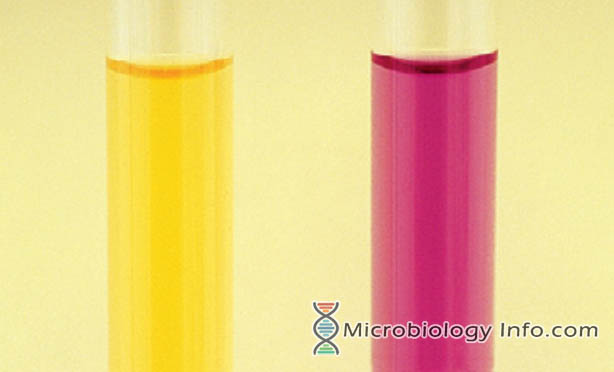The ability of the bacteria to grow in the presence of variable amount of Sodium Chloride (NaCl) has been used to characterize several bacteria. It takes into account the organism’s ability to tolerate various osmotic concentrations. E. faecalis, E. zymogenes, E. liquifaciens, and E. durans are among the Enterococcus species that are salt tolerant.
Objective
To determine the ability of an organism to grow in high concentrations of salt.
Principle
Salt acts as a selective agent for bacteria and interferes with membrane permeability and osmotic equilibrium. A high salt concentration thus inhibits a range of bacteria but allows salt-tolerant organisms such as enterococci to grow. To demonstrate the ability of such organisms in the laboratory, broth containing 6.5% NaCl is used as the test medium. The broth includes the fermentable carbohydrate, dextrose, and the color indicator, bromcresol purple. Organisms capable of growing in the high salinity medium, utilize the sugar and release acid as a byproduct of their metabolism. The pH drop results in the indicator, bromcresol purple, to change from purple to yellow.
Media: Brain-heart infusion broth (BHI) may be used with the addition of NaCl and an indicator dye.
Components: Heart digest (10 g), enzymatic digest of animal tissue (10 g), NaCl (65 g), dextrose (1 g), bromocresol purple (0.016 g), per 1000 mL.
Method
- Inoculate one or two colonies from an 18- to 24-hour culture into 6.5% NaCl broth.
- Incubate the tube at 35°-37°C in ambient air for 48 hours.
- Examine tubes for turbidity after 24 hours and if negative again at 48 and 72 hours.
Expected Results
- Positive: Visible turbidity in the broth, with or without a color change from purple to yellow. Note: Turbidity alone is indicative of a positive test
- Negative: No turbidity and no color change after 72 hours of incubation.

Uses
- It is used to differentiate enterococci (positive) from non-enterococci (negative).
- It is used to differentiate non-beta-hemolytic strains of catalase- negative, gram-positive cocci (i.e. Enterococcus and Aerococcus) based on their ability to grow in a 6.5% sodium chloride broth.
- Aerococcus species such as A. viridans and A. urinae can also grow in 6.5% NaCl, therefore salt tolerance broth can also be used to differentiate Aerococcus species from other similar organisms such as Stomatococcus and Helcococcus.
Limitations
- It is recommended that biochemical, immunological, molecular, or mass spectrometry testing be performed on colonies from pure culture for complete identification.
- Some strains of Pediococcus, Leuconostoc, and beta-hemolytic Streptococcus species may grow in Salt Tolerance Broth
- Infusion broth with 6.5% NaCl may produce slow reactions thereby making test interpretation difficult.
- A light inoculum must be used when inoculating broth. Too heavy an inoculum may produce turbidity, thus resulting in a false-positive result.
References
- Tille P.M. 2014. Bailey and Scott’s diagnostic microbiology. Thirteen edition. Mosby, Inc., an affiliate of Elsevier Inc. 3251 Riverport Lane. St. Louis. Missouri 63043
- https://www.dalynn.com/dyn/ck_assets/files/tech/TS27.pdf
- https://catalog.hardydiagnostics.com/cp_prod/Content/hugo/NaCl65Media.htm
- https://www.austincc.edu/microbugz/handouts/Salt%20Tolerance.pdf
- https://www.bioscience.com.pk/topics/microbiology/item/239-salt-tolerance-test
Similar Posts:
- Oxidase Test- Principle, Uses, Procedure, Types, Result Interpretation, Examples and Limitations
- Mannitol Salt Agar for the isolation of Staphylococcus aureus
- Selenite F Broth- Composition, Principle, Uses, Preparation and Result Interpretation
- PYR Test- Principle, Uses, Procedure and Result Interpretation
